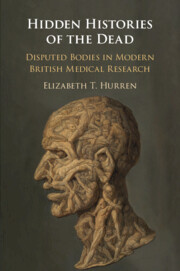Illustrations
3.1Photograph of ‘Mrs Craigie’ for an article by Margaret Maison, ‘The Brilliant Mrs Craigie’, The Listener Magazine, 28 August 1969, Issue 2109, p. 272, copyright cleared under creative commons Attribution Non-Commercial Share Alike 4.0 International (CC BY-NC-SA, 4.0), authorised here for open access, and non-profit making for academic purposes only.
3.2Publicity photograph of ‘Students Dissecting at the New Medical Centre’ ©University of Leicester – see, https://www2.le.ac.uk/departments/medicine/resources-for-staff/clinical-teaching/images/students-in-dissecting-room/view, accessed 10 January 2017, authorised for open access, and non-profit making, reproduced here under (CC BY-NC-SA, 4.0), for academic purposes only. Authorised by the University of Leicester where the author works.
3.3©Wellcome Image, L0014980, ‘Photograph of Newcastle Dissection Room 1897’, by J. B. Walters, copyright cleared under creative commons Attribution Non-Commercial Share Alike 4.0, reproduced here under (CC BY-NC-SA, 4.0), authorised for open access, and non-profit making for academic purposes only.
3.4©St Bartholomew’s Hospital Archives, Photographic Collection, ‘Dissection Room, 1915’, copyright cleared under creative commons Attribution Non-Commercial Share Alike 4.0, reproduced here under (CC BY-NC-SA, 4.0), authorised for open access, and non-profit making for academic purposes only
3.5©Wellcome Images, s3_L0018000_L0018253, ‘The New Operating Theatre at St Bartholomew’s Hospital around 1910’, looking recognisably modern with its stacked lecture theatre seats, Wellcome Trust Collection, digital download image reference, https://wellcomecollection.org/works/mtgyyb5w, reproduced under (CC BY-NC-SA, 4.0), authorised for open access, and non-profit making for academic purposes only.
5.1©Wellcome Images, Reference Number V0010903, A Juror Protesting that the subject of the Coroner’s Inquest is alive; showing the dangers of blind faith in doctors when declaring medical death – Coloured aquatint by Thomas McLean, 26 The Haymarket, London, c. 1826, copyright cleared under creative commons Attribution Non-Commercial Share Alike 4.0 International, reproduced here under (CC BY-NC-SA, 4.0), authorised for open access, and non-profit making for academic purposes only.
5.2©Wellcome Images, Reference Number L0062513, Watercolour drawing done by Leonard Portal Mark on 7 July 1894, depicting the face and chest of a man (unnamed) to show the appearance caused by rapid post-mortem decomposition. It was made about twelve hours after death, during the hot weather of July 1894 at St Bartholomew’s Hospital dissection room, copyright cleared under creative commons Attribution Non-Commercial Share Alike 4.0 International, reproduced here under (CC BY-NC-SA, 4.0), authorised for open access, and non-profit making for academic purposes only.
5.3©Wellcome Images, Reference Number L0029414, ‘Royal Liverpool University Hospital: a pathologist cutting open a body in the mortuary’, original drawing on site by Julia Midgley, Liverpool, 1998, artwork dimensions 42 x 29.7cm, copyright cleared under creative commons Attribution Non-Commercial Share Alike 4.0 International, reproduced here under (CC BY-NC-SA, 4.0), authorised for open access, and non-profit making for academic purposes only.



